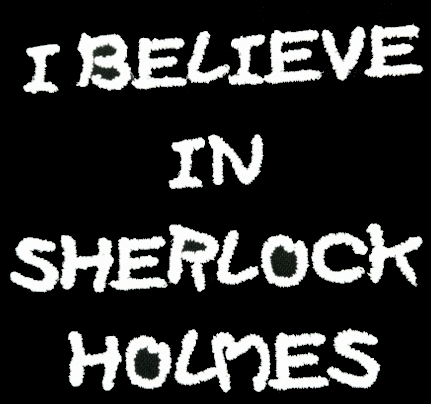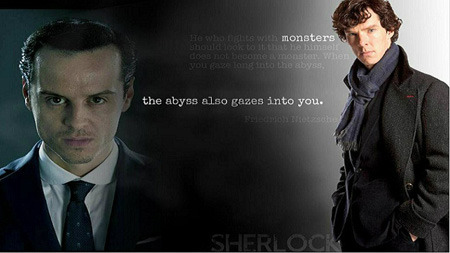
BBC Sherlock Fan Forum - Serving Sherlockians since February 2012.
- Dramagod
- Mycroft's Contact
 Offline
Offline 
- From: Finlandia
- Registered: June 13, 2012
- Posts: 549
Random questions about "A Study in Pink"
1. When Sherlock and John get to the crime scene where they found the lady in pink, Lestrade says a bunch of kids found her. Doesn't seem like the kind of building where kids would hang around or play games. And just break into a room. Also, could it be these kids had something to do with the kids who screamed bloody murder in TRF when they saw Sherlock? I mean we know it was Moriarty who nudged the cabbie in Sherlock's direction. Maybe the kids were given a hint to check the place so the lady in pink would be found.
2. The locations where the victims were found were said to be places the victims had no reason to be. Why did they choose those locations? Is it because the cabbie said he knows abandoned places around the city that would be good places to murder someone? So the cabbie takes the victims to these locations, does the "if take the red pill, I'll show you how deep the rabbit hole goes" -routine, and when the camera shows the victims taking the pills, the cabbie is basically in that same room but outside the frame?
3. The flat John is seen in a couple of scenes (where he stores his gun in the drawer), is that John's current rental apartment? Because it doesn't look like a big place, you'd think he could afford that one better, than the 221B flat.
4. Why does Sherlock have two red lava lamps? Who the hell has two that are even the same color. I have a red one myself.
5. When Sherlock is having their quiet chat with the cabbie and his pills, John is about to leave 221B when he hears a beep from the computer. It's the tracing signal of the pink phone. Why does it beep at that very moment, since the computer has been searching the signal all this time. Is it because the signal has stopped moving (the cab stopped)?
Last edited by Dramagod (June 26, 2012 8:41 pm)
-------------------------------------------------------------------------------------------------------------------------------------------------------------------
My blog: 3sidestoeverystory.tumblr.com
- veecee
- Official Blogger
 Offline
Offline 
- From: USA
- Registered: June 11, 2012
- Posts: 1,794
Re: Random questions about "A Study in Pink"
Dramagod wrote:
1. When Sherlock and John get to the crime scene where they found the lady in pink, Lestrade says a bunch of kids found her. Doesn't seem like the kind of building where kids would hang around or play games. And just break into a room. Also, could it be these kids had something to do with the kids who screamed bloody murder in TRF when they saw Sherlock? I mean we know it was Moriarty who nudged the cabbie in Sherlock's direction. Maybe the kids were given a hint to check the place so the lady in pink would be found.
2. The locations where the victims were found were said to be places the victims had no reason to be. Why did they choose those locations? Is it because the cabbie said he knows abandoned places around the city that would be good places to murder someone? So the cabbie takes the victims to these locations, does the "if take the red pill, I'll show you how deep the rabbit hole goes" -routine, and when the camera shows the victims taking the pills, the cabbie is basically in that same room but outside the frame?
3. The flat John is seen in a couple of scenes (where he stores his gun in the drawer), is that John's current rental apartment? Because it doesn't look like a big place, you'd think he could afford that one better, than the 221B flat.
4. Why does Sherlock have two red lava lamps? Who the hell has two that are even the same color. I have a red one myself.
5. When Sherlock is having their quiet chat with the cabbie and his pills, John is about to leave 221B when he hears a beep from the computer. It's the tracing signal of the pink phone. Why does it beep at that very moment, since the computer has been searching the signal all this time. Is it because the signal has stopped moving (the cab stopped)?
1. I thought by "kids" Lestrade meant teenagers. Could've been bored and looking for something to do. Looking for a place to drink or make out...
2. Yes.
3. To me it kind of looked like a bare-bones hotel room. I thought he was staying there temporarily while trying to figure out what he was going to do.
4. Probably a souvenir of some case! ![]()
5. I thought about that, too.
- Davina
- Moderator
 Offline
Offline 
- From: The Only Way is Essex UK
- Registered: February 9, 2012
- Posts: 9,714
Re: Random questions about "A Study in Pink"
1. Yes he would have probably meant teenagers, although it could have been younger children; they can run pretty wild in the city you know and abandoned buildings are always an attraction.
2. The cabbie actually says to Sherlock about how being a cabbie is useful because you get to know the quiet spots at certain times of the day.
3. Remember also that Mrs. Hudson is giving Sherlock a good deal on the rent of the flat as he helped her get her husband executed in Florida. Between them it might have been the same sort of cost for John. Also it makes it seem more appealing to him when he first goes in, compared to his dismal little room. Recall he says about how nice it could be...if it was tidied up a bit.
4. No idea. Maybe they help relax him.
5. Maybe it is because the cab has stopped.
![]()
---------------------------------------------------------------------------------------------------------------------------------------------
Don't make people into heroes John. Heroes don't exist and if they did I wouldn't be one of them.

- Dramagod
- Mycroft's Contact
 Offline
Offline 
- From: Finlandia
- Registered: June 13, 2012
- Posts: 549
Re: Random questions about "A Study in Pink"
Do I understand correctly that Sherlock already lives at 221B before John moves in? I mean all his stuff are there and the room does look lived in. But Mrs. Hudson does greet him at the door like she hadn't seen him in a while. If Sherlock has lived there, why does he suddenly need a flatmate?
-------------------------------------------------------------------------------------------------------------------------------------------------------------------
My blog: 3sidestoeverystory.tumblr.com
- •
- Sammy
- British Government
 Offline
Offline 
- Registered: May 17, 2012
- Posts: 665
Re: Random questions about "A Study in Pink"
Yes, he just moved in. He thought it was "very nice", so he immediately put all his stuff there. That was not long ago, you can still see some boxes. He wouldn't have moved in there without a flatmate because he can't afford the rent on his own - that was the whole point of having a flatmate in the first place.
I rather curious where and how he lived before, though, haha...
- veecee
- Official Blogger
 Offline
Offline 
- From: USA
- Registered: June 11, 2012
- Posts: 1,794
Re: Random questions about "A Study in Pink"
In the canon, he lived on Montague (near the British museum) before 221B Baker Street. I remember because I have been on that street, and I got all excited about the very slight brush with Sherlock (BWS) when I read it.
- Sentimental Pulse
- Mycroft's Contact
 Offline
Offline 
- From: Harrisburg, Pa
- Registered: June 2, 2012
- Posts: 480
Re: Random questions about "A Study in Pink"
I akways assumed that John lived in some sort of VA hospital room or halfway house to get over his post traumatic disorder which turned out to be lack of action. ![]()
---------------------------------------------------------------------------------------------------------------------------------------------
Disguise is always a self portrait
- besleybean
- Threatened Knighthood
 Offline
Offline 
- From: Carnoustie, Angus, Scotland.
- Registered: October 4, 2012
- Posts: 21,376
Re: Random questions about "A Study in Pink"
I'm just reading The Casebook, so will probably visit here armed with questions, as I read each section!
So you'll gather I'm still currently on PINK.
There are a couple of things I want to mention, but I'll hang on at the mo, because maybe they are going to be discussed elsewhere in the book.
BUT: I read the bit where the Cabbie is described as having traced Sherlock...
See, I just assumed that Moriarty knew it was Sherlock and sent the Cabbie to Baker St.
So really my question is(or my questions are!): how much/how soon is Moriarty involved?
---------------------------------------------------------------------------------------------------------------------------------------------------------------
- Sherlock Holmes
- Administrator
 Offline
Offline 
- From: 221B Baker Street
- Registered: February 7, 2012
- Posts: 5,162
Re: Random questions about "A Study in Pink"
Moriarty is involved right from the beginning. He knows of Sherlock and is a "fan" of him long before Sherlock has ever heard the name Moriarty, which was why he arranged the cabbie to do the killings, knowing that Sherlock would get involved eventually...Why else would he sponsor a serial killer if not to get the attention of Sherlock Holmes?
As for the other questions, I think they've pretty much been covered. Question 5 about the signal on the phone. If the phone was out of range/signal at any particular point, then it might not have been picked up by the GPS. Also, these things sometimes take a long time to complete the search, they lag or get hung...kind of like a computer...
Sherlock lived on Montague Street before Baker Street. It was actually mentioned on his website. One of his very first entries is telling people not to send correspondence to his old address on Montague Street (and it's canon also). Apparently he was forced to move out after an argument with the landlord. He was obviously a lot less understanding of Sherlock's habits than dear old Mrs Hudson.
Even if John /was/ living in a fancier, flashier apartment, he might have been desperate to find somewhere cheaper because he really couldn't afford the rent anymore.
---------------------------------------------------------------------------------------------------------------------------------------------
Eventually everyone will support Johnlock.
Independent OSAJ Affiliate

- besleybean
- Threatened Knighthood
 Offline
Offline 
- From: Carnoustie, Angus, Scotland.
- Registered: October 4, 2012
- Posts: 21,376
Re: Random questions about "A Study in Pink"
Tho he doesn't appear to have been doing this.
John does appear to come straight from a hospital/hostel/halfway house sort of place...
---------------------------------------------------------------------------------------------------------------------------------------------------------------
- immortal
- Shooting The Wall
 Offline
Offline - Registered: December 30, 2012
- Posts: 13
Re: Random questions about "A Study in Pink"
In the books , the sign of four, it is mentioned that john is staying in a hotel and stays there until he spent almost all of his money, then he started to look for a flat mate.To me it looked like a small cheap motel.
I came here to ask a quite random question that has been nagging on my mind for some time though. I can't understand john's cell phone analysis.I mean I can't understand to how extent sherlock had been wrong.Can somebody explain it? Does john have an alcoholic sister, or were all sherlock's deductions wrong ?
Last edited by immortal (January 1, 2013 12:18 pm)
- besleybean
- Threatened Knighthood
 Offline
Offline 
- From: Carnoustie, Angus, Scotland.
- Registered: October 4, 2012
- Posts: 21,376
Re: Random questions about "A Study in Pink"
Yes, John does have an alcoholic sister.
So the ONLY thing Sherlock got wrong, was assuming Harry was male...easily done!
---------------------------------------------------------------------------------------------------------------------------------------------------------------
- Kerkerian
- Mycroft's Contact
 Offline
Offline 
- From: Germany
- Registered: March 10, 2013
- Posts: 579
Re: Random questions about "A Study in Pink"
Something which has been bothering me every time I watched the episode- when Sherlock goes to follow Lestrade to Lauriston Gardens, he says to Mrs Hudson "Might need some food, something cold will do."
It strikes me as odd, because he usually doesn't eat when he's on a case, and I don't think he wanted it only because of John.
So do you think this is just a slip, or has there been another purpose to it, such as giving Mrs Hudson the opportunity to emphasize she's not his housekeeper one more time? Or maybe Sherlock assumed he'd have solved the case by that night?
______________________________________________________________________________________________________
"Why, why? I mean, why, why?"
"Four excellent questions."
- besleybean
- Threatened Knighthood
 Offline
Offline 
- From: Carnoustie, Angus, Scotland.
- Registered: October 4, 2012
- Posts: 21,376
Re: Random questions about "A Study in Pink"
The latter I think.
---------------------------------------------------------------------------------------------------------------------------------------------------------------
- tobeornot221b
- One More Miracle
 Offline
Offline 
- From: Germany
- Registered: February 12, 2012
- Posts: 6,761
Re: Random questions about "A Study in Pink"
Kerkerian wrote:
Something which has been bothering me every time I watched the episode- when Sherlock goes to follow Lestrade to Lauriston Gardens, he says to Mrs Hudson "Might need some food, something cold will do."
It strikes me as odd, because he usually doesn't eat when he's on a case, and I don't think he wanted it only because of John.
So do you think this is just a slip, or has there been another purpose to it, such as giving Mrs Hudson the opportunity to emphasize she's not his housekeeper one more time? Or maybe Sherlock assumed he'd have solved the case by that night?
I think it's all about showing how Sherlock and John are on the same wavelength.
If John had listened carefully he would have recognized Mrs Hudson NOT being their housekeeper.
After Sherlock ran out of the flat John kind of absent-mindedly orders tea from her ("I'm not your housekeeper!") and "a couple of biscuits" ("...not your housekeeper!"). At this point, we, the TV audience, already consider the two of them being cut from the same cloth.
---------------------------------------------------------------------------------------------------------------------------------------------
John: "Have you spoken to Mycroft, Molly, uh, anyone?"
Mrs Hudson: "They don’t matter. You do."
I BELIEVE IN SERIES 5!

- Kerkerian
- Mycroft's Contact
 Offline
Offline 
- From: Germany
- Registered: March 10, 2013
- Posts: 579
Re: Random questions about "A Study in Pink"
That's very enlightening, thank you all! ![]()
______________________________________________________________________________________________________
"Why, why? I mean, why, why?"
"Four excellent questions."

 1 of 1
1 of 1